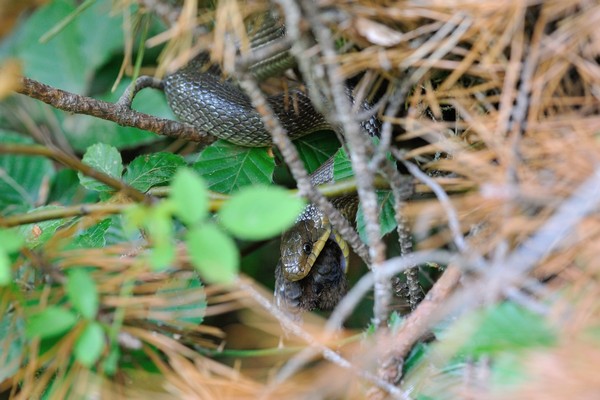Woopwoopwoop -- it's the 10th anniversary of this gem of a blog 🥳 You may have wondered, why there hasn't been any update for about a year. Well, I unfortunately didn't have much time for excursions, so there are not much new pictures to see. But now -- finally -- I've been on a field trip again! 4 days in Carinthia in the region of Arnoldstein, together with Günther, who, very unusually, wasn't writing on a new book for the total four days [have a look at those great books about grasshoppers and reptiles & amphibians of Vienna!].
It was a very nice and relaxed fieldtrip, the only goal was to visit the Schütt region and photograph and watch whatever animal we stumble upon. In the end, of course, we also took the opportunity to visit Horvath's rock lizard (Iberolacerta horvathi, Kroatische Gebirgseidechse) and were very happy about every nose-horned viper (Vipera ammodytes, Hornotter bzw. Hornviper) we found. Also we were surprised by the numbers of Aesculapian snakes (Zamenis longissimus, Äskulapnatter). Besides finding lots of interesting animals (and flowers!) we also ran into two fellow "fieldherpers", who by coincidence stayed at the restaurant where we ate dinner every day, and with whom we also spent some nice time.
All pictures below were photographed "in-situ", meaning not disturbing or touching the animals, which I'm very happy about and is meanwhile one of the main boundary condition for such trips.
 |
|
 |
 |
On top and bottom left the viviparous lizard (Zootoca vivipara / Bergeidechse), which I really like because they are usually quite shy, and quickly disappear into the lowest vegetation layer when you make too much of a ruckus. Bottom right one of the highlights in Carinthia - Horvath's rock lizard (Iberolacerta horvathi / Kroatische Gebirgseidechse). You can find both species in the same habitat, but Horvath's rock lizard is sitting, fitting to the name, on the rocky and vertical structures.
From the southern small tributaries in the Gailtal, where we saw the upper species, we continued to our main target region, the Schütt rockslide fields close to Arnoldstein. Most common reptile species there is the common wall lizard (Podarcis muralis / Mauereidechse, bottom left), but, speaking of lizards, also the European green lizard (Lacerta viridis / Östliche Smaragdeidechse) is not rare. During mating season the male European green lizards cannot be overseen due to their shining blue throat (top left and -- not really a "puzzle picture" -- bottom right). The female European green lizards (top right) lack the blue throat and have a comparatively smaller head.
 |
 |
 |
 |
Lizards -- check! But, of course, even though we said in the beginning, that we don't care what we see, we eventually also wanted to find some snakes. And we did! Actually we had some very exciting encounters with nose-horned vipers (Vipera ammodytes / Hornotter bzw. Hornviper), one of them was calmly sliding between us, literally between our feet. Another interesting and a little sad observation has been an Aesculapian snake that emptied a nest of Eurasian wrens (Troglodytes troglodytes, Zaunkönig). Actually Günther first noticed the continous alarm calls of the Eurasian wrens, and jokingly noticed "ah, surely an Aesculapian [snake] raiding their nest...". Coming closer it turned out to be true! Apart from that we found another Aesculapian basking completely exposed on the top of a huge pile of branches and about 4 nose-horned vipers. Two of them were actively crawling around, which was nice to watch.
 |
|
 |
|
 |
|
 |
 |
But not only herpeto-geeks will enjoy that region, also people with interest in other groups, like arthropods, will be very happy there! Those two spider species are quite common there: On the orchid (which should be Dactylorhiza fuchsii / common spotted orchid / Fuchs' Knabenkraut) one of the crab spider family (Thomisidae / Familie der Krabbenspinnen), and the others are males of the jumping spider Philaeus chrysops (Goldaugenspringspinne). I was also really glad to witness a combat between two Philaeus males -- they fight showing and using their fangs/chelicerae, but without biting each other (bottom left)! On another place, a male was guarding the nest of a female (bottom right, female is inside the web).
 |
|
 |
 |
Aaand, not to forget, there are sooo many interesting flowers there! We found about 7 or 8 orchid species -- just as by-catch without explicitly searching them. Bottom right the large-flowered butterfly orchid (Platanthera fornicata or Platanthera bifolia ssp. latiflora, I don't know what's the latest state of the nomenclature on that, Große Waldhyazinthe on German) and also the wild gladiolus (bottom left, Gladiolus illyricus, Illyrische Gladiole), the only place in Austria you can see it in nature!
 |
 |
And finally, some random pictures of that nice field-trip: in-situ photographing is easy!, typical field trip styling, and eol of (both) soles -- currently being repaired!
 |
|
 |
 |
Ah yes, the random song reference! This time from the band of the woman [Konstrakta], who made this year's Serbia's amazing contribution to the European Song Contest: Zemlja gruva! - Nisam znala da sam ovo htela